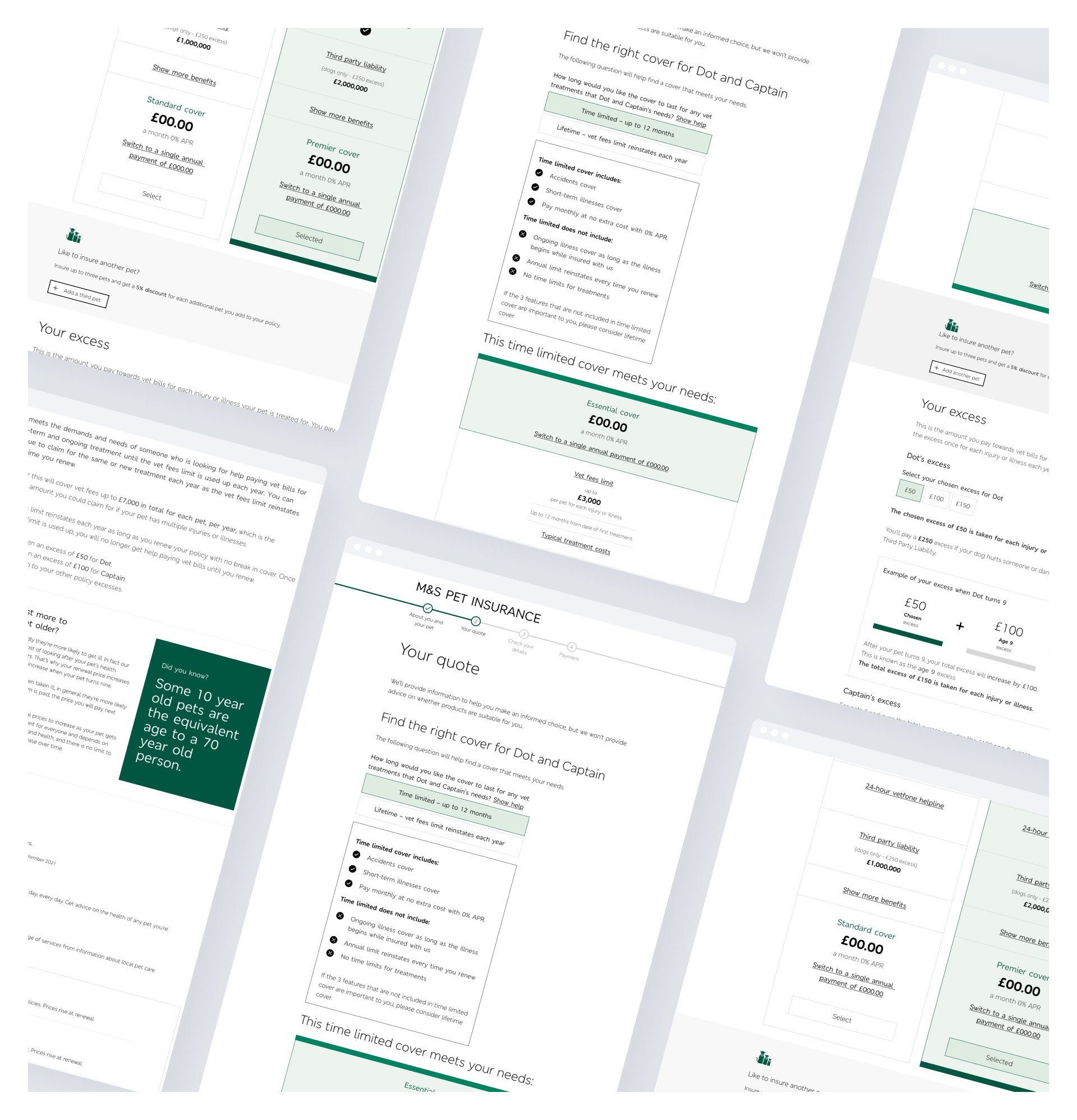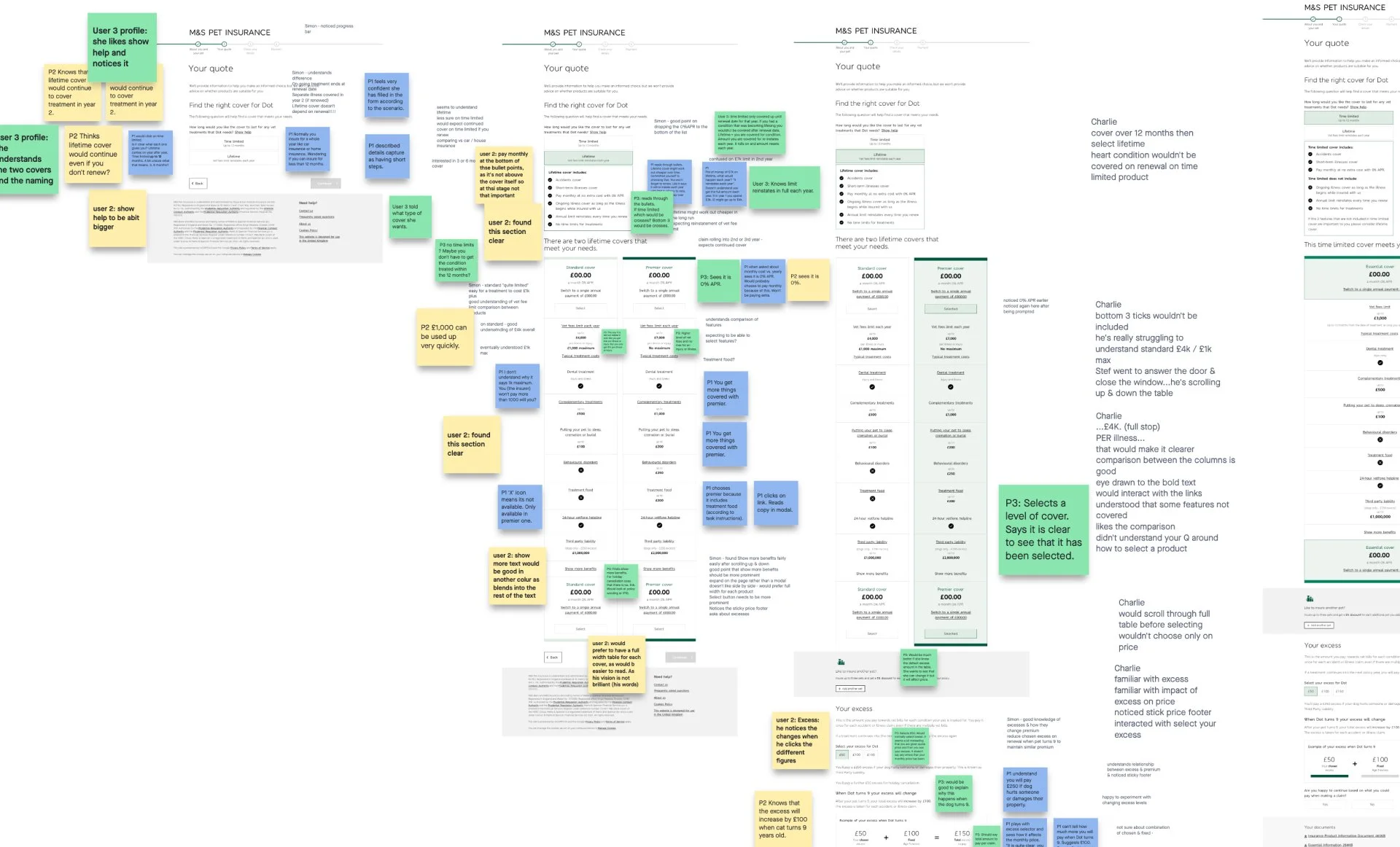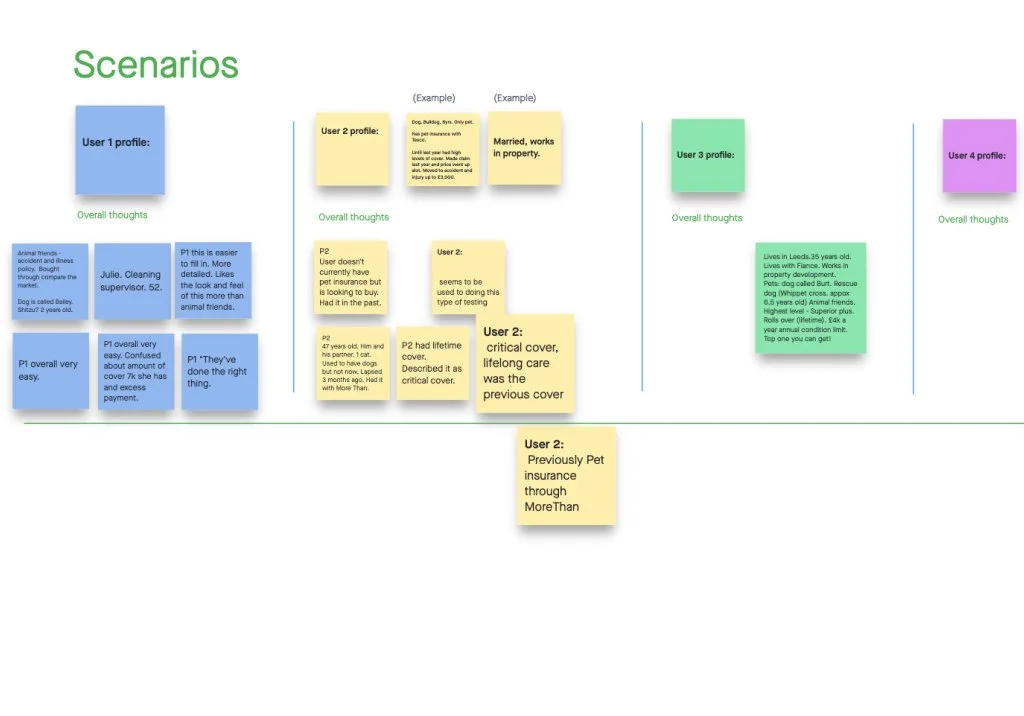CONTEXT AND GOAL
The current pet journey was developed several years ago and was plagued by usability issues and back-end bugs. The new version aimed to address these issues and enhance stability by incorporating components from the reliable internal design system, which had been successfully tested in other journeys.
To ensure the success of the journey, it was crucial to conduct thorough testing of the implemented changes. Testing the end-to-end journey provided valuable insights into how users navigate through the complete quote and buy process. By observing their behaviour and interactions, we were able to identify any potential pain points or areas for improvement. This approach allowed us to gather data and make informed recommendations to further enhance the journey for regular business operations.
Research | UX
CHALLENGES AND HYPOTHESIS
Employing the Scrum methodology and adhering to 2-week sprints, the double diamond approach emerged as a remarkably efficient and effective framework for addressing our project requirements. However, as we delved into the research and UX sprint, it became evident that due to various factors, an extension of the initial sprint was necessary to ensure the development, agreement, and thorough testing of the optimal user journey.
Our agile environment proved to be invaluable in facilitating this necessary adaptation. The team swiftly embraced the need for an extended sprint, demonstrating remarkable flexibility and cohesion. This adjustment underscored the inherent strength of the agile approach, allowing us to pivot and align our efforts seamlessly in response to evolving circumstances.
RESEARCH
The digital design team previously worked on designing the new pet product journeys for other clients. Although there are several similarities among these three journeys, the main difference lies in the quote summary. As a result, this research strategy primarily focused on the quote summary for M&S Bank, particularly regarding the product design.
One new challenge we had to address was the absence of specific limitations on vet fee choices within Essential or Premium tiers. The approach for M&S Pet new design involved prioritising mobile design and incorporating content design changes into wireframes before proceeding to hi-fidelity designs. During the design phase, testing was conducted, and it deemed necessary, for designs to be iterated based on the feedback from user testing.
UX WORKSHOPS
During the round of user testing, several bugs impacting customer journeys were identified. Numerous comments arose during the testing process, particularly concerning the quote summary and the absence of user-friendly components like comparison tables. These issues resulted in difficulties for users in comprehending the product they had selected. Additionally, users found it challenging to make sense of their decisions due to disconnected content scattered throughout the page.
PRODUCT INFORMATION
The quote summary in M&S displays information about both short-term and lifetime cover options. The lifetime cover is presented in a table format, consisting of two tiers. However, recent user testing revealed that the existing table performed poorly. Users were uncertain about the selected cover level, and the lack of interactivity regarding the benefits made it difficult for them to gather more information about each benefit.
To ensure the effectiveness of the journey, it is important to conduct end-to-end user testing. By observing how users navigate through the entire quote process, valuable insights can be gathered, which can lead to further recommendations for continuous improvement in regular business operations.
REFLECTION OF THE MODERATED USER TESTING
The testing process was generally successful for both desktop and mobile platforms. The identified issues during testing were consistent across both platforms. However, a significant red flag issue was raised concerning customers' understanding of the vet fee limits for multi-pet quotes.
Immediate action was taken to address this critical issue. The designs were iterated based on the feedback received, and retesting was conducted with participants. After the third iteration, the solution proved successful, and the results indicated improved clarity for customers. To further build confidence, additional user testing is being planned. This information is being shared with the Product, Commercial, and Creative (PCC) team, as well as the pet tribe, to ensure their awareness.
Other recommendations, labeled as amber, that arose during testing will be documented and added to the backlog for review and implementation after the go-live phase. These recommendations will be reviewed in the context of business-as-usual (BAU) operations to determine their feasibility and prioritise their implementation.
By addressing the critical issue promptly and documenting the remaining recommendations for future consideration, the team is actively working to improve the overall user experience and ensure a successful launch.
CHALLENGES AND OUTCOMES
The various moderated tests provided valuable insights into customers' understanding of the new products, including aspects such as pricing strategy and product naming. It also assess the effectiveness of the gradual reveal approach in showcasing the range of available coverage options. The primary objective of the tests was to enhance our understanding of how customers experience the journey. By capturing the thoughts and feelings throughout various stages, from brochureware to details capture and the quote summary, the aim was to gain a comprehensive understanding of their perspective.
The output of the testing phase enabled us to generate recommendations that go beyond the changes made to M&S's new product. We identified areas for improvement throughout the entire journey, taking into account customers' feedback and insights. This holistic approach ensured that our recommendations were comprehensive and encompass all aspects of the user experience.
WHAT I LEARNED
The moderated user testing provided an opportunity to observe and interact with users directly, gaining firsthand feedback on their reactions, preferences, and pain points. This deeper understanding of user perspectives enabled us to make informed decisions and improvements to ensure a more seamless and satisfactory experience for customers.
In essence, our agile mindset enabled us to seamlessly transition into an extended sprint, exemplifying the flexibility and effectiveness of both the double diamond approach and the Scrum methodology. This collaborative effort exemplifies our commitment to embracing change and aligning our actions to achieve the best possible results and enhance the overall product offering. This approach ultimately contributed to a more successful outcome for the new product, aligning it more closely with user expectations and needs.



